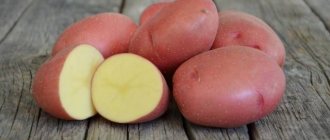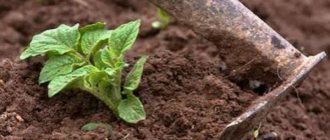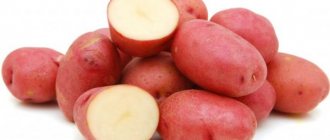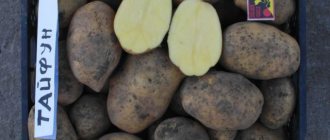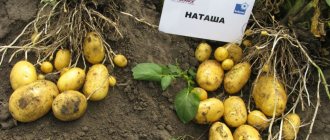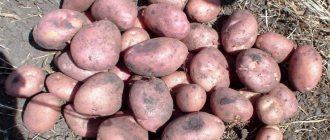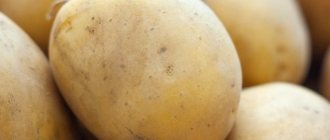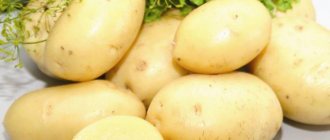Pest control with folk remedies
The Colorado potato beetle will not attack beds with Santa too persistently if legumes or flowers with a strong smell are planted next to the potatoes.
To stop the larvae collected from the bushes from developing, they are shaken into a bucket with a saturated saline solution. Wireworms and aphids will not grow in soil with low acidity, free from weeds and plant waste.
The Sante variety is not prone to degeneration, but still experienced vegetable growers renew the seed material once every five years. Plants selected for collecting planting material are collected together with the rest of the harvest, sorted by size and degree of integrity, dried and stored separately from potatoes intended for food.
In general, the Santa variety is not for everyone. For those who prefer mashed potatoes, this variety is not suitable, since the tubers contain a lot of starch. Otherwise, the variety has no downsides. The main thing is to follow the rules of agricultural technology.
Features of cultivation
Agricultural technology for this variety is standard. The variety is heat-loving; planting begins when the soil has completely warmed up. The soil is carefully loosened, plant remains and other unnecessary inclusions are removed. Old humus or wood ash is laid out in the holes. Tubers are planted at a distance of 35-40 cm, to a depth of no more than 10 cm. Wide row spacing is required. After hilling, high ridges are left. Mulching will help control weeds.
Potatoes love moderately moist soil. The ideal option is to organize drip irrigation. Fertilizing is applied twice per season.
Mineral complexes with potassium, magnesium and phosphorus are preferred, as well as organic matter (diluted mullein or bird droppings). An excess of nitrogen-containing fertilizers (urea or ammonium nitrate) leads to abundant growth of tops to the detriment of the development of tubers.
Read more about how to feed potatoes, when and how to apply fertilizers, and how to do it when planting.
Seed material is collected from the best, most productive bushes. They should not be affected by pests or viruses.
Suitable plants are marked in advance; after digging, the potatoes are sorted, dried and stored separately. The Sante potato variety is not prone to degeneration, but it is recommended to update the seed material every 5-6 years.
Potatoes easily tolerate mechanized harvesting , tubers are resistant to mechanical damage. After harvesting, careful drying followed by sorting is required.
The use of various chemicals when growing potatoes causes controversy and controversy. We bring to your attention useful information about why and how herbicides and insecticides are used when growing potatoes.
Planting and growing Sante potatoes
Obtaining abundant harvests, according to vegetable growers, is possible provided that the gardener adheres to some of the rules set out below:
- will prepare for Santa light, fertile, oxygen-enriched soil in which legumes, radishes, cabbage or mustard greens previously grew. It is better to choose an area that is exposed to the sun for most of the daylight hours;
- will dig up a plot of land allocated for potatoes twice: the first time in the fall, and the second time before planting. Feed the beds with mineral fertilizers;
- will begin planting potatoes after warm weather sets in;
- will not give aphids and Colorado potato beetles a chance to develop.
Features of growing Santa potatoes - ripening period
The Sante potato variety was developed by Dutch breeders. In 1993, the culture was included in the State Register of the Russian Federation. Due to the heat-loving nature of the vegetable, planting in open ground is carried out after the ground has completely warmed up. This variety belongs to the mid-early table types of vegetables. Below the article provides information about Santa potatoes (varietal characteristics), reviews, taste.
Ripening dates, diseases and pests
The duration of the entire ripening period - from pipping of the first shoots to harvesting the fruits - is from 80 to 90 days. The variety is characterized by high yield; at least 27 tons of potatoes can be harvested from 1 hectare.
For your information! The maximum yield limit can reach 50 tons per 1 hectare, provided that the soil and the method of caring for the growing crop meet the requirements of agricultural technology. To obtain a bountiful harvest, it is necessary to apply organic and mineral fertilizers in a timely manner.
Sante very rarely gets sick with scab and potato cancer. Potatoes are not afraid of almost all viral diseases. The exception is late blight. In order to prevent late blight, the beds are moved to a new location every season, and the soil is treated with specialized preparations before planting potatoes. Excessive irrigation of the Sante variety can lead to the development of blackleg.
Important! The main enemies of Santa are the Colorado potato beetle, wireworm and potato aphid.
Description of the vegetable: climate preferences and taste qualities
The bushes are low-growing, the foliage is simple, juicy green. The stems are erect with a well-developed rhizome and rather large but neat tubers. It blooms with large white flowers collected in small corollas.
From one bush you can collect 15–20 root vegetables. The weight of one potato reaches from 100 to 150 g. The root crops, dotted with many superficial, almost inconspicuous eyes, have a smooth, thin but dense yellow skin. The variety is unpretentious to storage conditions.
Sante potatoes are bred for consumption in specific areas and are designed for planting in certain climatic zones. These include the northern regions, Western Siberia, the Far East, as well as the Central, Lower Volga and Volga-Vyatka regions.
Judging by reviews from gardeners, Sante potatoes have a pleasant taste and help quickly satisfy hunger. Boils quickly. As a result of heat treatment, potatoes do not lose their original shape and color. The variety is suitable for baking, making semi-finished products and chips. Can be prepared stuffed.
Note! Potatoes contain a small amount of starch (10-14% per vegetable), so they are not suitable for making mashed potatoes. Ideal for deep frying.
Advantages and disadvantages of the variety
The advantages of the variety include:
- early ripeness and high yield;
- uniform germination and ripening of root crops;
- low maintenance;
- non-susceptibility to accidental damage during mechanical harvesting;
- satisfactory taste;
- ability to resist most infectious diseases.
The disadvantages of Sante potatoes include susceptibility to temperature changes and soil composition, as well as the inability to tolerate even slight frosts.
Planting and growing Sante potatoes
Obtaining abundant harvests, according to vegetable growers, is possible provided that the gardener adheres to some of the rules set out below:
- will prepare for Santa light, fertile, oxygen-enriched soil in which legumes, radishes, cabbage or mustard greens previously grew. It is better to choose an area that is exposed to the sun for most of the daylight hours;
- will dig up a plot of land allocated for potatoes twice: the first time in the fall, and the second time before planting. Feed the beds with mineral fertilizers;
- will begin planting potatoes after warm weather sets in;
- will not give aphids and Colorado potato beetles a chance to develop.
Experienced vegetable growers recommend planting Santa in open ground in the last days of April or after the May holidays. The exact planting date depends on how quickly spring comes into its own. Experts recommend pushing back the planting date until mid-May, since at this time the soil will have already warmed up to a depth of 10 cm, and the likelihood of frost returning is negligible.
Potato Sante, as it is also called, does not tolerate proximity to weeds, so the ground must be cleared of excess grass, first immediately before planting, and then as it appears. The procedures for harrowing and irrigating the soil are no less important: the first must be carried out twice a season, and the second as the soil dries out and during the formation of flowers.
Note! Excessive amounts of moisture can cause rotting of the root system and the tubers themselves.
Rules for planting and care
You can start planting potatoes after loosening the soil, removing weeds and remnants of last year's crops. Planting material is laid out in pre-fertilized holes dug to a depth of 10 cm. Old humus or ash is used as fertilizer. Leave 35–40 cm between rows.
The Sante potato variety develops well in moderately moist soil, so it needs frequent irrigation in the summer season. Most gardeners who grow this crop prefer to organize a drip irrigation system, setting it up in such a way that the soil, while receiving the required amount of moisture, is not washed away.
Twice during the season, the soil in which Sante develops is enriched by adding mineral and organic fertilizers. The amount of fertilizing containing nitrogen is minimized so that excess of this substance does not lead to increased growth of tops and, accordingly, to a slowdown in the development of root crops.
According to experienced growers, the best fertilizer for the soil in which Sante grows is mineral fertilizers and organic matter in the form of solutions of cow and bird droppings. With proper care, harvesting can begin 80 days after emergence.
Important! If the crop is not harvested in a timely manner, it can become prey for garden pests.
Features of watering
The first time watering is carried out after the emergence of seedlings. Approximately 3 liters of water are poured under one bush.
Plants must be moistened at the stage of formation of buds and flowers. By moistening the soil during these important periods for the crop, the gardener will achieve an increase in the number of root crops. Recommended dosage of water is 4–5 liters. After the tubers have fully ripened, watering is stopped. Excess moisture can lead to infection with a disease such as potato rot.
In rainy weather, provided that the rainy season began during the period of planned moisture, and the soil is saturated with water to a depth of 20 cm, the irrigation procedure is abolished.
Note! It is better to water in the evening, when the heat has subsided and the potato tops are protected from sunburn. In very hot weather, watering is completed by loosening the soil between the rows, followed by mulching.
Feeding and fertilizing
Potatoes of all varieties love organic fertilizers, which include manure, bird droppings and ashes. In addition to organic fertilizers, the plant needs nutrients containing nitrogen, potassium, wood ash and superphosphate. Each of the listed elements is introduced in due time:
- nitrogen - after the appearance of the first shoots. A tablespoon of fertilizer is diluted in 10 liters of water. Half a liter of fertilizer is poured under each bush;
- potassium and ash - during the formation of buds. A tablespoon of potassium sulfate and 3 tbsp. spoons of ash are diluted in 10 liters of water. Feed each bush with 0.5 liters of solution;
- superphosphate - after the start of flowering, during the formation of tubers. 2 tbsp. spoons of superphosphate are diluted in a bucket of water. Half a liter of fertilizer is poured under each potato bush.
Important! Fertilizers are poured under a pre-watered plant.
If the time for applying nitrogen is missed, you should not feed the potatoes with nitrogen-containing substances. If applied later than the prescribed period, nitrogen will provoke the growth of green mass, which will affect the development of tubers.
Description of the variety
The Sante variety is mid-early, 80-90 days pass between planting and harvesting. Productivity depends on soil fertility, weather conditions and where the variety grows. Nevertheless, the yield indicators are quite high: from 275 to 500 centners per hectare. Experienced gardeners give a positive description of the Santa variety potatoes, confirming them with reviews and photos.
- The bush is small, compact, of medium height;
- The plant does not produce abundant green mass;
- The root system is well developed, which contributes to abundant tuber formation. One bush produces up to 20 potatoes;
- The tubers have a round or oval-round shape;
- Each weight reaches 150 g;
- The tubers are the same size;
- The peel is yellowish in color, thin but dense, protecting the tubers from damage. Potatoes are well transported and have a marketable appearance that is attractive to buyers and is well stored;
- There are many ocelli, but they are superficial and shallow. The tubers are easy to clean and remain smooth;
- When cut, the potatoes are colored a pleasant yellow color, the taste is very good;
- A special feature of the Sante variety is its small proportion of starch (10 - 12.5%). This means that the potato tubers will not boil over during cooking, but will retain their shape. The Sante variety is best suited for making French fries, fried potatoes, seasoning soups, baking and stuffing. The tubers have an excellent taste, peeled, and do not darken for a long time. When cooked, a crispy crust forms;
- The variety is rich in vitamins B, C, amino acids and microelements;
- The choice of Sante potatoes is also supported by the fact that this variety is resistant to diseases that usually affect early and mid-early potato varieties. The Sante variety is resistant to late blight, the most dangerous potato disease, which can cause loss of more than 70% of the harvest. The variety is not affected by potato scab, viruses and nematodes.
The Sante variety has a number of advantages. That's why Russian gardeners fell in love with it. Many remain faithful to the variety for many years also because it is not capricious when grown. Looking at the photo, it becomes clear that the description of the Santa variety potatoes is true.
Related video: how to prepare Santa potatoes for sprouting
Potatoes of the Sante variety have many positive qualities - they are tasty, suitable for preparing many dishes, easy to care for and resistant to most dangerous diseases. However, when planting potatoes on unsuitable soil or violating agricultural cultivation techniques, there is a risk of getting complete disappointment instead of a rich harvest. Therefore, if the characteristics of your site do not allow you to grow Santa, it is better to stop at some other variety.
Rate this article:
[Votes: 0 Average: 0]
Planting and caring for Santa potatoes
Despite the fact that Santa is an unpretentious variety, you need to pay due attention to planting and care, because this is the only way to count on a high yield and excellent taste. The leaving process is as follows:
- after the seed has been planted, the ground should be leveled with a rake;
- it is necessary to remove weeds in a timely manner, as they inhibit the crop;
- periodic loosening allows you to enrich the soil with oxygen;
- Thanks to hilling, you can get rid of weeds, warm young shoots and retain moisture in the soil.
In addition, it is worth choosing the right seed material, as a result of which the harvest will be large and attractive in appearance.
Selection and preparation of a landing site
It is recommended to plant potatoes on a flat, well-lit area of land. The optimal solution is to choose fertile land. As a rule, site preparation begins in the autumn. The work algorithm looks like this:
- Remove weeds.
- They spread manure.
- In autumn, they dig up the soil to a depth of 30 cm.
- In the spring, the area is re-digged to a depth of 15 cm.
- The emerging weeds are removed again.
- Apply a small amount of fertilizer.
Land plots on which mustard or lupins previously grew have good indicators.
Important! Potatoes grow much worse in the shade; the tubers will be small in size with an elongated shape
Preparation of planting material
In addition to describing the Santa potatoes, it is important to know how to properly prepare planting material. Small potatoes that do not have mechanical damage are used for planting.
If necessary, the process of obtaining a finished crop can be accelerated, for which the potatoes are allowed to germinate:
- If there is dirt, the tubers are filled with water and the soil is cleaned.
- After the planting material has dried, it is laid out in a well-ventilated area at a temperature of +15°C.
- Santa's potatoes are turned over for 14 days.
- Tubers are ready for planting after shoots up to 1 cm long appear on them.
As a rule, seed germination begins a month before planting in open ground.
Landing rules
To plant the Sante variety, use the following scheme:
- between rows maintain a width of 60 cm;
- The distance between bushes varies from 35 to 40 cm.
This planting scheme allows the bushes to receive a sufficient amount of light; in addition, there will be no problems at the time of hilling. If the soil is light and loose, then the planting depth is 8-10 cm. For dense soils, the indicators are reduced to 3 cm. If groundwater is close to the site, it is recommended to use the ridge planting method.
Advice! After the planting material is planted, it is recommended to level the ground with a rake.
Watering and fertilizing
Watering should be moderate:
- Water for the first time after the shoots have appeared (up to 3 liters of water for each root);
- the next watering occurs at the stage of buds and flowering;
- After the root system has fully matured, stop watering the potatoes.
Manure is used as top dressing, which is scattered on the site in the fall; mineral fertilizers are applied in moderate quantities before planting.
Loosening and weeding
During the process of potato growth, do not forget about loosening, thanks to which you can enrich the soil with oxygen. As a rule, soil loosening is carried out at the moment of hilling, when the earth rises up. At the same time, it is worth removing weeds. If you remove weeds in a timely manner, you can prevent the occurrence of most types of diseases, which will allow you to get a good harvest with an attractive appearance and excellent taste.
Hilling
Since Santa potatoes are tall, it is recommended to hill them at least 3 times:
- after the tops have reached a height of 20 cm (covered with earth up to the top);
- 14 days after the first hilling;
- after another 21 days.
Thanks to the earth collected around the bushes, the potatoes have additional space for growth and development.
